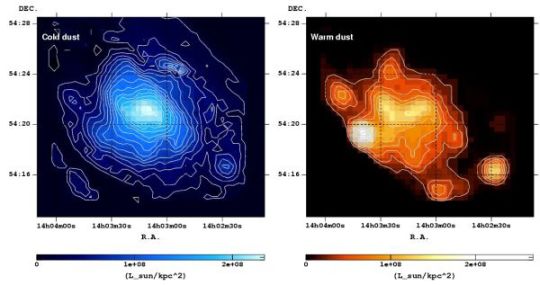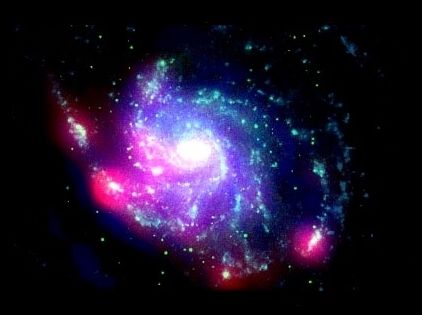AKARI Results
Active star formation viewed from the outside: The peculiar spiral galaxy M101
M101 is a spiral galaxy in the constellation Ursa Major lying about 24 million light years from the Earth. Its diameter is about 170 thousands light years, making M101 twice the size of our own Galaxy. Many young high-temperature stars populate the spiral arms with a remarkably giant star forming region present in the outermost arm in the galaxy. In order to investigate the star-formation activity in the galaxy we have carried out high-spatial resolution observations in all four wavelength bands of the FIS (65, 90, 140, and 160 micrometres). With these data we have been able to reveal the distribution of the the 'warm' dust heated by the young high-temperature stars in the star-forming regions, and the 'cold' dust warmed by the normal stars typical of our own Sun (see Figure 1).

Figure 1: Distribution of cold (left) and warm (right) dust in the spiral galaxy M101 observed by the FIS.
Figure 2 is a false colour image of the AKARI/FIS data shown together with the image of the same galaxy in visible and far-ultraviolet light to contrast the different distributions of the two dust components in the galaxy. It is seen that the warm dust is distributed along the spiral arms with many hot spots along the outer edge in the galaxy. These spots correspond to giant star-forming regions. On the other hand the cold dust clumps itself nearer the centre of the galaxy and in general is more evenly distributed over the entire galaxy.

Figure 2: Distribution of cold (blue) and warm (red) dust overlaid on the visible (green; showing distribution of stars) and far-ultra violet (cyan; indicating the location of young stars) images of M101.
The amount of warm dust should correspond to the formation rate of young, high-temperature stars while the amount of cold dust is indicative of the amount of gas required for the star formation. This means that active star formation is taking place where more warm dust than the cold dust is present. The AKARI/FIS data indicates that more active star formation is taking place in the giant star-formation regions situated in the outer regions of the galaxy than in the central region. In contrast, it is generally believed that star formation is more active in the central part of spiral galaxies like our own Milky Way. AKARI has revealed that M101 is a rather peculiar case having active star formation regions in the outermost extents of the galaxy.
M101 is known to have experienced a 'tidal interaction' with a companion galaxy in the past. It is suspected that the gas dragged out from the hapless companion is now falling onto the outer edge of M101 at relatively high speeds (approximately 150 km/s) triggering the active star formation. In fact observations show that the gas is indeed falling onto the outer part of the galaxy, although it is not fully understand why this is the case. Several more nearby galaxies have been observed by AKARI and these observations will throw further light on the physical mechanisms responsible for the active star formation in galaxies.
Materials
- Figure 1 (© ?)
- Figure 2 (© ?)





